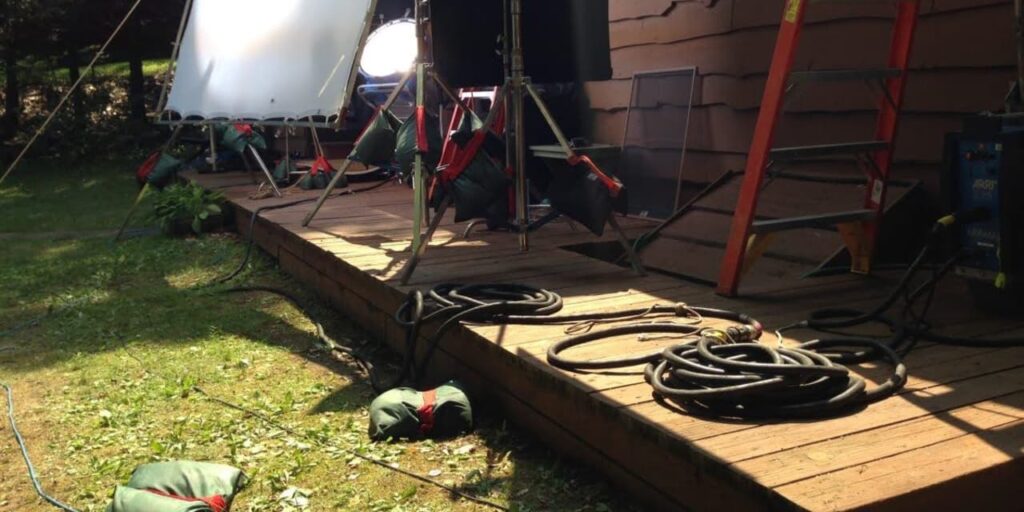This article is reprinted by permission from The Escape Home, a newsletter for second homeowners and those who want to be. Subscribe here. © 2024. All rights reserved.
I was obscured behind a big lakeside rhododendron, looking up the stone steps toward the actors hard at work on the lawn in front of our little weekend house in the Hudson Valley.
Playing a family in turmoil, the actors shouted and cursed at each other. Christina Applegate then gave Billy Crudup, who was playing her husband, a resounding slap across the face.
Things went quiet for a moment and Frank Langella, playing the family’s elderly patriarch, began making his way slowly and painfully down the uneven steps.
Still hidden, I marveled at this lion of stage and screen, famous since “Dark Shadows” and a major star since playing Nixon in “Nixon and Frost,” as he hobbled down the steps, the weight of the world on his shoulders.
What’s his acting process, I wondered. What is going through his mind right now as he plays this part? What is he thinking?
As the director called “Cut!” Langella stepped onto the lakefront patio. He noticed me and turned toward the rhododendron.
“Hey Tim,” he called. “What’d you pay for this place?”
Beyond the realization that even movie stars sometimes think about mundane things while working, it was an eye-opening experience to have our escape home used as a movie location.
It all started for us when I got an email out of the blue from a location scout. Was I interested in having part of a movie shot at our house? We would get paid, the email promised.
We emailed back and forth. He told me it was an independent movie with a well-known cast, and the producers were willing to pay five figures to use the house for a few days.
He wanted to know whether our neighbors might object. I gave him contact information and suggested he ask them himself.
He said homeowners usually aren’t present when a movie shoots, but I said I wanted to be there; I was curious about seeing how the whole thing would work.
He got back to me: the neighbors were cool and the director said I could stay as long as I kept out of the way.
I asked the location agent why he chose our house. There are many nicer houses on our lake. “We don’t want a nice house,” he said. “The script calls for a more rustic place.” I think he almost said rundown instead of rustic.
We soon made a tentative deal. The location agent sent a contract outlining how many days the movie crew would be at our house, how much we’d be paid, and the insurance provisions. I signed, and we set a date for Joel David Moore, the “Avatar” actor directing his first feature film, to visit for pre-shoot planning.
Moore showed up with about 30 other people to scope out our property. What rooms could they use? Which scenes would be shot where? The camera and lighting and sound people poked around.
How deep was the lake right off the patio? They were pleased they’d be able to put the cinematographer in waders to shoot Frank Langella walking down the steps. They asked me if they could move our swim raft and sailboat so that the place would look less fancy.
That’s when I learned that the movie, titled “Youth in Oregon,” in a play on the word “euthanasia,” was about an aging New York doctor (Langella) who was diagnosed with a terminal illness and decided to go to his family’s longtime semi-abandoned lake cabin in Oregon, where he could to take advantage of legal physician-assisted euthanasia. His already-fractured family (besides Billy Crudup and Christina Applegate, including Mary Kay Place, Nicola Peltz and Alex Shaffer) was further divided over his suicide plan, and gathered against his will at the cabin to escalate their arguments.
Scoping out our place, the director and crew apparently liked what they saw. They gave the final okay to use the house, and scheduled four days – one to stage the house, two for the actual shooting, and a final day to put everything back in place.
In the days before shooting, a few neighbors asked for details. A couple of people said they were going to drop by just in case any extras were needed.
A couple of neighbors seemed miffed. “Why your house instead of mine?” one demanded. Each time, I replied, “They were looking for a place that looked kind of abandoned. Your house is too nice.”
On the prep day, half a dozen young people showed up. Consulting instructions on printouts and phones, they began moving our stuff into the garage. They replaced our books with their books. They took down our pictures and put up their pictures. They taped duct tape that looked like knotty pine over our granite counter, creating the illusion of a wooden counter. Instant rustic.
The first day of shooting, the director brought about 60 people. We’d never had more than two dozen for a party, and the movie people overran our little place. Some were young women who did hair and makeup. Some were sturdy guys shouldering cases and equipment, beams and lights. They set up big white screens to reflect light, and ran strands of thick multi-colored wiring everywhere, all leading to the truck generator parked in the next-door neighbors’ driveway. (The neighbor on the other side got a truck in her driveway, too: the so-called “honey wagon,” the multi-stalled toilet trailer used by the crew instead of our bathrooms.)
The crew moved purposefully, inside and out, setting up scenes. The actors sometimes rehearsed, and always became their characters at Joel Moore’s calls of “Action!” At one point he called my name and I stepped forward, ready for my closeup. But all he wanted was an old teapot they could put on the counter. Later he asked to borrow some beat up binoculars.
One thing I learned right away: movie people are not your guests. They are not going to treat your house like a home. It is their workplace. I bit my tongue when the guys moving heavy equipment began walking up and down the small hill to the lake straight across the lawn instead of using the sidewalk and steps.
I discovered so-called craft services, a long table staffed by people who maintain an abundant supply of food all day: muffins, croissants, sandwiches, hot dogs, fruit, candy and all sorts of snacks. It’s all freely available, even for the homeowner, except during the evening meal break.
For the evening meal break, everything stopped. We all made our way down the road past the neighbor’s house where the actors rested between scenes to yet another neighbor’s house where a big tent was set. Long tables groaned under a buffet of salads, pasta, meat, vegetarian and vegan offerings, gluten free stuff and a range of fruit and desserts. It was like a giant friendly picnic.
During one of these breaks, I encountered a family walking back and forth on the small road in front of our house. They were grumpy. “We came over here to see movie stars,” the dad complained, ”and the only person we recognize is you.”
The second day of shooting, the town building inspector showed up and inspected all sorts of stuff that didn’t need to be inspected, followed by several deputy sheriffs and a couple of state troopers straying off their usual highway patrols. I introduced them to Frank (Langella and I being on a first-name basis by then) and he spent a few minutes asking about their jobs and thanking them for their service.
Langella took an interest in the younger actors, and gave them career advice. When I asked him to look back on his career, he replied, “I never thought I’d be rich.”
He was rich enough to ask me to name my price when he began to covet our wicker Morticia chairs. I told him I had to check with my wife.
“Checking with the wife,” he mused. “That’s why I’m not married anymore.”
By the time shooting finished, after midnight on the second day, I was done. I was really looking forward to getting our home back. As the last of the gear was loaded into trucks with lights flashing, the location manager found me. “So,” he asked. “Would you let your house be used as a location again?”
“Probably not,” I said immediately. I was tired of having all those people literally crawling all over our home. Then I thought for a second and added, “Well, actually, maybe I would do it again. You know, if the movie included someone I’d like to meet. Maybe Meryl Streep.”
Author’s footnote: I have not heard from any more location scouts, nor Meryl Streep. Despite some good acting, “Youth in Oregon” did not do well at the box office or with the critics. Its Rotten Tomatoes rating is 45 percent. It can be watched on a number of streaming services. Our house is featured in the final scenes, when things turn rustic.
Here are a few tips if you’re thinking about making your home available for movies, TV shows or commercials.
- Don’t think your house isn’t right. Sometimes the script calls for something very specific – and it’s not always the nicest house on the block.
- Get in touch with film location agencies and offer your house, with lots of photos. Our shoot was arranged by a freelance location scout working directly for the movie. Location agencies try to match your house with producers. They also charge you 20%-30% commissions.
- Check with your city, regional or state government agencies promoting film production; they may offer advice and connections.
- If you get some interest, make sure you get what you want in the contract, such as adequate insurance, the timing of the shoot, what spaces can and cannot be used, and whether you can be present. If you have any doubts about any part of the contract, show it to a lawyer.
- Try to have the movie people make the first offer. They may be willing to pay more than you anticipate, so don’t lowball yourself. No matter what they say, ask for a little more. Ask to be paid partially or fully in advance.
- Find out from state agencies or your tax advisor whether you need to pay income tax on all or part of your fee. Some locales offer tax breaks to encourage filming in their area.
- Take photos of everything before the prep people come in. They will take photos, too, but have your own backup.
- If there’s damage left behind, or anything missing, report it to the production company right away and ask for replacements or repairs.
This article is reprinted by permission from The Escape Home, a newsletter for second homeowners and those who want to be. Subscribe here. © 2024. All rights reserved.
Read the full article here












